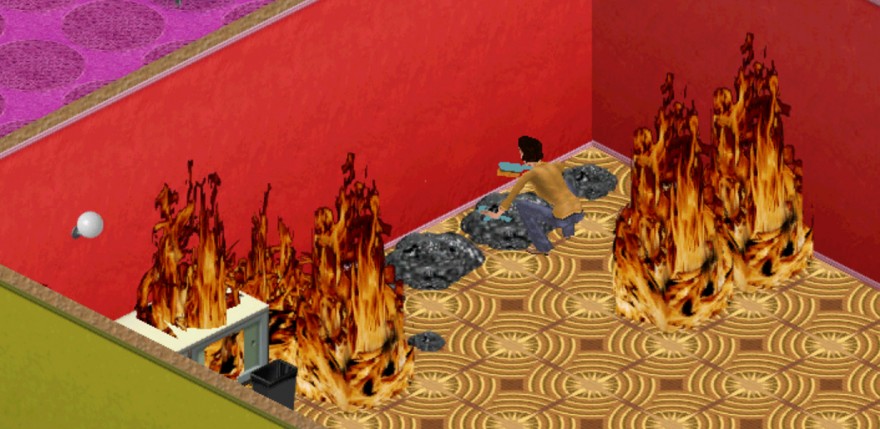Imagine Schrödinger’s Sim: He is penned in a world you have created, a world filled with dangers that may or may not kill him. You walk away from your computer to make some Kraft Dinner—the radioactive orange kind, accept no substitutes. While you munch away on your macaroni-and-cheese-like product, your Sim is either alive or dead. You can’t be sure. But until you return to your computer, he is not conclusively dead. So do you go back? If you do and find him to be dead, has your return not killed the Sim?
Death and technology—gaming included—now interact in all sorts of strange ways. It’s tempting to see these interactions as edge cases, which surely some of them are. But death and technology overlap in too many ways for that to be a particularly satisfying explanation. These issues inform Memory Burn, an exhibit at New York City’s bitforms gallery that is running until August 16, 2015, and purports to “observes mortality and death in relation to recording devices.” (Disclosure: The exhibit’s curator, Chris Romero, is a former Kill Screen intern.)
Four of the exhibit’s entries—Angela Washko’s “Womanhouse” “Disposable Muses” “You’re Either In Or Out” and “At The Expense of Watching”—turn The Sims into a series of macabre social experiments. As part of Washko’s “Free Will Mode” video series, these entries reimagine the architecture of The Sims so that it is hostile to the existence of avatars: rooms cease to have doors; swimming pools become inescapable prisons.
The avatars, unlike actual humans, accept this state of affairs. In Washko’s videos, they go about their lives, and do normal human-slash-avatar things, even if the world they exist is conspiring to kill them. Washko writes that these avatars “expose a greater cultural phenomenon within people- the extent to which we accept the hand we’ve been dealt (architecturally, politically, socially, economically).” To the extent that it is a simulation, you can think of it as Battle Royale against the built environment.
Not all of Memory Burn’s entries touch on gaming. Two entries from Andrea Wolf’s “Unsolicited Memories, Archival Exercises” series project found footage onto Plexiglas cubes that flicker on and off, the loss and rediscovery of memory becomes a story unto itself. In a similar sense, Rafael Lozano-Hemmer’s “Level of Confidence” is so close yet so far away. It uses police facial recognition algorithms to match the viewer’s face with the 43 victims of the 2014 Iguala mass kidnapping. The algorithm will not produce matches because the students Raúl Isidro Burgos Rural Teachers’ College of Ayotzinapa are believed to have been massacred, but its continual operation keeps the search alive. Lozanno-Hemmer has open-sourced the project and suggests that other use cases could include “someone who trains the algorithms with images from missing aboriginal women in Canada.” Sadly, the potential uses of this installation abound.
While the entries in Memory Burn blur the line between digital and physical death to interesting effect, it’s not as if the two are entirely separated anyhow. When you die, what becomes of your digital footprint, of the memories it encompasses? This is now an actual estate-planning question. As you might imagine, creepy startups are on the case. The world Memory Burn imagines, where memories of the deceased are repurposed as installations—often as a way of extending their lives—is rapidly approaching.
